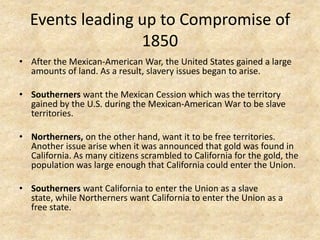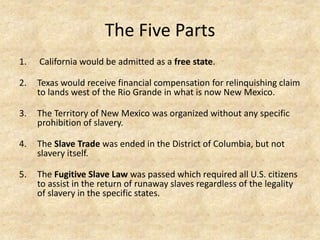Us history group project (craig, nikki, and alyssa)
- 1. US History Group Project Group III: Craig Maggio, Nikki Kozminsky, & Alyssa Barchetta
- 2. The Compromise of 1850 By Craig Maggio
- 3. Events leading up to Compromise of 1850 • After the Mexican-American War, the United States gained a large amounts of land. As a result, slavery issues began to arise. • Southerners want the Mexican Cession which was the territory gained by the U.S. during the Mexican-American War to be slave territories. • Northerners, on the other hand, want it to be free territories. Another issue arise when it was announced that gold was found in California. As many citizens scrambled to California for the gold, the population was large enough that California could enter the Union. • Southerners want California to enter the Union as a slave state, while Northerners want California to enter the Union as a free state.
- 4. What happened during the Compromise of 1850? • The Compromise of 1850 was a series of bills aimed at resolving the territorial and slavery controversies arising from the Mexican- American War from 1846 to 1848 • There were five laws which balanced the interests of the slave states of the South and the free states to the north.
- 5. The Five Parts 1. California would be admitted as a free state. 2. Texas would receive financial compensation for relinquishing claim to lands west of the Rio Grande in what is now New Mexico. 3. The Territory of New Mexico was organized without any specific prohibition of slavery. 4. The Slave Trade was ended in the District of Columbia, but not slavery itself. 5. The Fugitive Slave Law was passed which required all U.S. citizens to assist in the return of runaway slaves regardless of the legality of slavery in the specific states.
- 6. Who benefited from The Compromise of 1850? • The Compromise of 1850 favored the South and enabled slavery to expand in the U.S. • It avoided the Wilmot Proviso which was a previous attempt to ban slavery in lands acquired from Mexico during the Mexican American War or in the future, which meant that the New Mexico territory, Utah Territory, and Texas panhandle could now become slave states. • Another thing that upset the northern states was that The Compromise of 1850 also established a stronger Fugitive Slave Act, which declared all runaway slaves be brought back to their owner. Anyone helping runaway slaves could face a 6 month prison sentence and large fine, even if the slave was in a free state
- 7. Who was negatively impacted by The Compromise of 1850? Negatives of The North • The territories that we acquired from Mexico might all want to enter as slave states which would unbalance America. • The southerners could all join together and make all states have slavery. The citizens of the North had to return the runaway slaves because of the Fugitive Slave Act.
- 8. Evaluation: States Rights • More power to states and people allowing for them to determine whether they would want slavery so instead of providing power to fed. Gov’t the states and people were able to gain more power….expand more
- 9. Fugitive Slave Law By Alyssa Barchetta
- 10. Before Fugitive Slave Law… • In 1850 the political balance was upset as the number of free states was allowed to exceed the number of slave states. • The United States was eager to admit California as a state after the discovery of gold in 1848, but the Wilmot Proviso (1846) prevented slavery anywhere in the new territory gained from Mexico. Thus California could only be admitted as a free state. • Southerners viewed the resulting imbalance as a threat to their very way of life; they feared that the federal government would soon be dominated by an antislavery agenda. • The Compromise of 1850 sought to pacify the South in several ways: The admission of California was balanced by the fact that the Utah and New Mexico territories were allowed to determine their own free or slave status through popular sovereignty. But the farthest-reaching aspect of the compromise was the inclusion of the Fugitive Slave Law.
- 11. The Fugitive Slave Law • Any person aiding a runaway slave by providing shelter, food or any other form of assistance was liable to six months' imprisonment and a $1,000 fine. • Those officers capturing a fugitive slave were entitled to a fee and this encouraged some officers to kidnap free Negroes and sell them to slave-owners. • Frederick Douglass, Wendell Phillips, William Lloyd Garrison and John Greenleaf Whittier led the fight against the law. Even moderate anti- slavery leaders such as Arthur Tappan declared he was now willing to disobey the law and as result helped fund the Underground Railroad. • In simply terms, the fugitive slave law: forced northerners to give back slaves that where either hidden or taken in during the escape of slaves and if they did not do so and slaves were found in their possession they were fined. • Also, it put all fugitive cases under federal jurisdiction.
- 12. Positive and Negative Impacts • Positive for the South—the plantation owners were getting their runaway slaves back. But there is a negativity because the north didnt want to follow this law since it was made by the south and they weren't going to be able to get all the slaves back. • Negative for the Slaves—This was devastating to free African Americans living in the north, because they could no longer legally prove that they were free. Many were sent back into slavery in the south. Thousands of fugitives living in the north fled to Canada in order to escape being sent back into slavery. • Negative for the North—it was a “lose lose” situation they would be criticized for not enforcing the law, and turning their backs on the south but then again if they go along with the law they would be considered helping out slave trade which they didn't want to be involved with.
- 13. Evaluate: States Rights • It benefited states rights but in another way hurt it. The South created this law since their reserved power allows the states to control all laws over slavery because slaves are "property." But in the North the South is talking away Northern rights and forcing the North to obey their state law.
- 14. Popular Sovereignty By Nikki Lee Kozminsky
- 15. Background Information • This idea goes back to when the South wanted slavery to expand while the north was trying to restrict it. The name derived from John C. Calhoun “squatter sovereignty.” However, Douglas was primary promoter. He along with many of other people who also agreed with this hoped that applying this in new territories would preserve the union, but they discovered that it was not so. This concept would only work if most people voted in favor of slavery in the new territories. They would later find that this would not be realistic.
- 16. During “Popular Sovereignty” • First, it is significant to understand what it is. It was a political doctrine stating that the people who lived in a region should have the right to choose for themselves the nature of their government. This was done for those new territories and how they would enter the union, as a free or slave state. It was applied by Stephen Douglas and included in the Compromise of 1850 and through the Kansas- Nebraska Act.
- 17. Positive Effects… • It appealed to most Congress members because it removed the slavery issue from national politics. It was also democratic giving the people the ability to choose. Even some of the Northerners believed that thei rpeople would settle into those new territitories and ban slavery.
- 18. Negative Effects… • The Northern abolitionists argues that this didn’t give African Americans the rights they deserved or the extreme southerners it was the safe option.
- 19. Evaluation: States Right’s • I don’t agree with it, but I do think this was a step in the right direction for State’s. It was a step towards democracy even though the topic at hand might not be humane.
- 20. The End Hope You Enjoyed




















